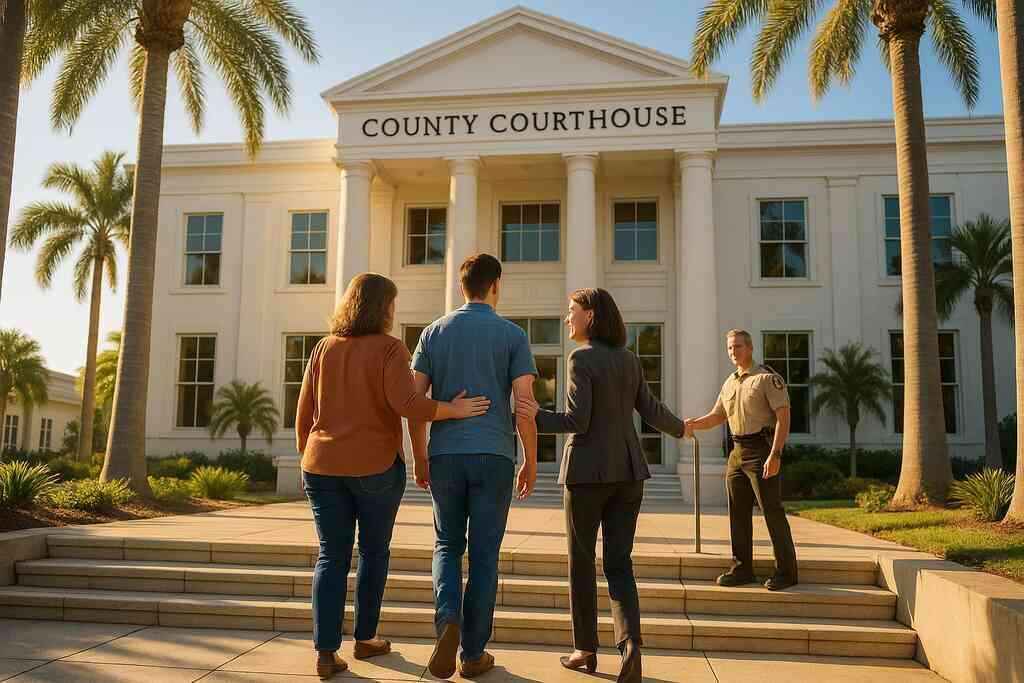Unveiling the Dual Pathway to Recovery and Justice
Why the Marchman Act Florida matters for families today
The Florida marchman act has evolved from statute to emotional lifeline for thousands of households statewide. Many parents notice mood swings, secretive spending, or late-night calls and fear their child may not survive another binge. By allowing relatives to petition court quickly, the law bridges compassion with accountability and prevents tragedies headlines cannot erase. Current data show petitions rising alongside fentanyl deaths, confirming that families demand structured help over passive hope. A recent study on the impact of Marchman Act on Florida families found early legal action improves long-term sobriety rates. The finding reinforces why awareness matters.
Understanding how to file a marchman act petition begins with clarity about Florida civil procedures and court jurisdiction. Families should collect hospital records, police reports, and dated conversations to demonstrate imminent danger from ongoing substance misuse. Photographs of neglected hygiene and videos showing slurred speech further validate the urgent need for involuntary treatment options near me. Judges appreciate concise timelines, so organize events chronologically and highlight worsening signs of withdrawal families should recognize. An intervention specialist can polish the narrative, ensuring every allegation aligns with statutory language and medical best practices.
Sobriety and legal rights a shared destination
Legal protection and sobriety travel the same road, though the scenery shifts from courtroom benches to clinical group rooms. After a judge signs the order, marshals escort the individual to an assessment, not a jail cell. That distinction affirms constitutional rights while acknowledging the medical nature of addiction. Florida civil lawsuits traditionally focused on damages, yet this remedy seeks restoration through supervised detox and therapy. The marchman act Florida process therefore unites due process with public health, offering hope without erasing human dignity.
Successful petitions often lead to integrated plans that include detox, intensive outpatient programs, and monitored sober living. Court liaisons track attendance, while clinicians report progress, enabling judges to adjust requirements rather than impose blanket penalties. Clients learn that legal compliance and wellness milestones overlap, creating positive feedback loops instead of adversarial standoffs. Families reinforce this synergy by arranging transportation, scheduling therapy reminders, and coordinating community AA meetings near you for continued support. When legal oversight gradually recedes, the behavioral routines built during supervision stand firm, sustaining freedom beyond the courtroom.
Mapping the Legal Landscape of the Florida Marchman Act Process
Understanding Florida civil procedures in substance abuse cases
Navigating addiction law starts with clear knowledge of Florida civil procedures governing health emergencies. Petitions operate within strict timelines, affidavits, and service rules that echo ordinary lawsuits yet carry lifesaving urgency. Families collect evidence, notarize statements, and file in the county where the individual resides or is found. Judges then determine probable cause during ex-parte review, often the same day. For deeper guidance and downloadable forms, explore the comprehensive Marchman Act resources in Florida offered by seasoned intervention teams.
Civil procedure also safeguards due process for respondents who might resist treatment. After the judge’s preliminary order, clerks schedule a hearing within days, ensuring the person can contest allegations. Sheriffs must personally serve the order, and failure to appear can result in a pick-up writ. This measured pace balances urgency with constitutional protection, satisfying both public safety and individual rights. Mastering these steps prevents procedural misfires that could delay urgently needed care.
Florida court system tiers from county to supreme court
Florida’s court hierarchy influences every Marchman Act filing. County courts hear initial petitions, verify evidence, and authorize assessment or stabilization. If legal complexities arise-such as jurisdictional disputes or venue challenges-cases can move to the circuit court level. Circuit judges wield broader authority, including extended treatment orders beyond initial stabilization periods. Their rulings establish precedents that guide clerks and clinicians statewide.
Above the trial tier, district courts of appeal analyze contested decisions for statutory consistency. Advocates frequently cite district opinions when crafting arguments about treatment duration or payment responsibility. The Florida supreme court seldom reviews Marchman cases, yet its interpretations of civil commitment law shape every lower ruling. Understanding this pyramid equips families and attorneys to anticipate potential appeals. It also clarifies why meticulous documentation at the county level can withstand higher-court scrutiny.
When involuntary treatment is the humane option
Choosing involuntary treatment feels daunting, but ongoing substance use often erodes voluntary decision-making capacity. The Florida Marchman Act allows loved ones to request court-ordered help when overdose, violence, or medical decline looms. Clinicians testify that rapid admission saves lives otherwise lost during waiting-list delays. Philosophically, the statute reframes commitment as a medical rescue, not a punitive sentence. This humane intent aligns with modern neuroscience showing addiction’s grip on brain reward circuits.
Families exploring involuntary treatment options near me often fear reputational harm or legal backlash. Courts address those worries through sealed medical records and limited public access. Judges frequently encourage collaborative plans that include detox, counseling, and community support. For a nuanced discussion of mandated care, review the detailed article on the role of involuntary treatment via Marchman Act and learn how compassion and jurisprudence intersect. Armed with facts, petitioners can act confidently before another crisis erupts.
Baker acted versus marchman acted lines in the sand
Florida distinguishes mental-health emergencies from substance-induced impairment through separate statutes. The Baker Act governs psychiatric crises where danger stems from mental illness, while the Marchman Act addresses threats rooted in substance misuse. Clinicians assess presenting symptoms-psychosis, suicidal ideation, or severe withdrawal-to decide which pathway applies. Misclassification can delay care or violate rights, so clarity matters enormously.
Legal timelines differ as well. A Baker Act hold typically lasts seventy-two hours, whereas a Marchman assessment order may extend to five days, followed by treatment up to ninety days. Funding sources, reporting requirements, and discharge criteria also diverge. Detailed comparison charts, case studies, and statutory excerpts appear in the primer covering Baker Act statutes in Florida. Understanding these lines in the sand helps families request the correct intervention and avoid procedural detours.
Filing a petition near me timeline and checklist
Effective petitions follow a precise yet manageable timeline. Start by gathering police reports, medical records, and firsthand testimonies documenting recent dangerous behavior. Complete the standardized petition form, attach supportive affidavits, and swear before a deputy clerk or notary. Pay the modest filing fee or request indigent status if finances are strained. Most counties schedule an ex-parte review within one business day, allowing rapid court action.
Create a checklist covering transportation arrangements, preferred treatment centers, and post-detox housing. Include contact information for intervention specialists willing to testify about relapse patterns. Prepare to update the court on progress, because judges often require written status reports. When you anticipate each procedural checkpoint, the court-ordered rehab timeline feels less intimidating. Diligent preparation also reassures the bench that your primary motive is recovery, not punishment.

Emergency Intervention and Clinical Realities
Recognizing subtle signs of withdrawal before crisis hits
Families often miss early danger because symptoms appear mild at first glance. Shakiness, yawning, or unexplained sweating might seem harmless yet hint at chemical dependency. For an expert checklist, review the signs of withdrawal families should note and compare them with recent behavior changes. Quick recognition empowers relatives to act before seizures, delirium, or overdose strike. By trusting gut instincts and monitoring subtle cues, loved ones gain a decisive head start.
Equally important, keep a written log documenting every observable symptom. Courts value timely, organized evidence when evaluating a marchman act Florida petition. Dates, times, and descriptions reveal escalating risk that verbal anecdotes cannot capture alone. Add photos of neglected hygiene or empty bottles to strengthen the narrative. Thorough records reduce courtroom doubt and accelerate lifesaving orders.
Collaborating with intervention specialists for rapid response
Once red flags surface, delaying professional help can prove disastrous. Licensed interventionists understand Florida civil procedures and can mobilize within hours. Reach out through the dedicated contact for Marchman Act legal assistance page to assemble a multidisciplinary team. These specialists coordinate family meetings, gather affidavits, and brief attorneys on jurisdictional nuances. Their guidance transforms panic into a structured action plan.
After the initial consult, interventionists often stage a rehearsed conversation that balances firmness with compassion. They outline treatment options, transportation logistics, and legal rights, easing fear for everyone involved. In Broward, Miami-Dade, or rural counties, they know which clerks accept after-hours filings. By keeping communication open, families avoid missteps that could invalidate a petition. Coordination also reassures the court that community resources stand ready to support compliance.
Court ordered rehab timeline from filing to intake
Timing matters once the paperwork reaches the clerk’s desk. A well-drafted petition can yield an ex-parte order the same business day. If you live in Jacksonville, the streamlined pathway for a Marchman Act filing in Duval County illustrates how speed and precision intersect. Sheriffs typically serve respondents within twenty-four hours, and assessment must begin shortly thereafter. Knowing each checkpoint prevents surprises and sustains momentum.
Next comes clinical intake, where medical teams evaluate detox needs, psychiatric status, and co-occurring disorders. Families should prepare insurance cards, medication lists, and emergency contacts ahead of transport. Judges appreciate proactive organization, and it minimizes wait time in holding areas. Early medical stabilization reduces withdrawal complications and sets a cooperative tone for future hearings. Efficient handoffs keep everyone focused on recovery rather than bureaucracy.
Protecting patient confidentiality during legal motion
Even under court oversight, patient dignity remains paramount. Clerks seal sensitive exhibits, and judges routinely restrict public access to medical details. When briefing counsel, refer to the memorandum comparing privacy statutes in comparing Baker Act and Marchman Act procedures to ensure compliance. Always use initials on social media to prevent unintended exposure. Respectful silence protects reputations and supports therapeutic trust.
Further safeguards include encrypted email for document exchange and locked storage for printed files. Treatment providers must follow HIPAA protocols, forwarding only essential updates to the court. Families should designate a spokesperson to avoid conflicting statements. Streamlined communication minimizes leaks and strengthens the legal standing of the petition. When confidentiality stays intact, respondents feel less threatened and more open to care.
Cost breakdown and funding resources for mandated treatment
Finances often intimidate families considering involuntary care, yet options exist to lighten the burden. Many county courts waive filing fees for indigent petitioners, and state funds cover initial stabilization for uninsured residents. For ongoing therapy, explore scholarships within accredited addiction treatment programs throughout Florida. Sliding-scale payment plans and workplace assistance programs can bridge remaining gaps. Early budgeting ensures no treatment day gets lost to paperwork delays.
Insurance carriers must honor mental health parity laws, meaning substance abuse services receive equal reimbursement. Verify network status of detox centers and intensive outpatient programs before commitment. Veterans may qualify for additional federal coverage, while students sometimes access campus-based grants. Social workers help navigate these channels, translating policy jargon into actionable steps. By demystifying costs, families maintain focus on healing rather than invoices.
Treatment Pathways after the Judge Signs
From detox to intensive outpatient programs a continuum of care
The judge’s signature turns crisis into structured momentum, beginning with medically managed detox. Licensed clinicians monitor vitals, ease withdrawal, and build rapport that smooths future transitions. Once stabilization ends, the Florida Marchman Act pathway usually shifts to intensive outpatient programs in Florida that meet several times weekly. This flexible schedule lets participants hold jobs or attend school while receiving cognitive-behavioral therapy, relapse education, and family counseling. Because the court still watches attendance, every missed session triggers rapid accountability rather than quiet regression.
Equally important, treatment teams coordinate warm handoffs between each level of care. Case managers share progress notes, ensuring no information gap endangers recovery momentum. They also teach clients how to navigate Florida civil procedures tied to weekly compliance reports. When legal oversight aligns with clinical insight, motivation rises and ambivalence fades. Families notice restored routines, healthier sleep, and renewed honesty, reinforcing hope that felt impossible during active use.
Dual diagnosis addiction treatment services under court oversight
Many respondents struggle with untreated depression, trauma, or anxiety alongside substance misuse. Dual diagnosis services integrate psychiatric evaluation, medication management, and evidence-based therapies within the same facility. Judges appreciate this comprehensive approach because untreated mood disorders often sabotage sobriety plans. Therefore, orders frequently specify cognitive processing therapy, EMDR, or dialectical behavior skills groups. By naming these modalities, the court underscores that mental health parity is not optional but essential.
Clinicians submit concise progress updates that satisfy Florida district courts without breaching confidentiality. They note medication adherence, session attendance, and observable mood shifts rather than private disclosures. This balanced reporting meets statutory requirements while protecting therapeutic trust. Over time, clients learn symptom-tracking techniques that empower them beyond the courtroom. As psychiatric stability increases, cravings decrease, proving that whole-person care supports long-term compliance.
Top sober house and RECO Institute transitional living
After completing structured programming, many individuals still need supportive housing that enforces sobriety routines. Top Sober House residences around Florida offer curfews, regular drug testing, and peer accountability. For enhanced clinical integration, families often select RECO Institute transitional living, which partners with Reco Intensive outpatient treatment in Delray Beach for seamless step-down care. Residents attend group therapy nearby, return to supervised housing nightly, and practice life skills such as budgeting or meal planning. This environment bridges the vulnerable gap between treatment completion and independent living.
House managers also coordinate with probation officers or court liaisons to verify ongoing compliance. Mobile apps log curfew check-ins, while random breathalyzer tests deter impulsive drinking. Because rules are clear and consequences swift, residents internalize structure rather than resent it. Gradually, privileges expand-later curfews, weekend passes, or part-time work-rewarding consistent responsibility. Such graduated freedom mirrors broader goals of the Florida court system: safeguarding the community while nurturing personal agency.
Relapse prevention plans tailored for court compliance
A strong relapse prevention plan starts with identifying high-risk situations unique to each client. Therapists employ functional analysis to map triggers-arguments, paydays, or certain neighborhoods. Then they craft coping strategies that fit court restrictions, like arranging early curfews on weekends when temptation spikes. Written agreements list emergency contacts, approved travel zones, and mandatory check-in schedules. Because these documents become part of the legal file, they carry weight that verbal promises lack.
Moreover, clinicians teach mindfulness, urge-surfing, and craving journaling to build internal resilience. Biofeedback tools track stress levels, alerting clients before anxiety peaks. Families participate through weekly meetings that model assertive communication without enabling. Should a slip occur, predetermined action steps activate-extra therapy sessions, more frequent drug screens, or brief return to residential care. Swift intervention prevents minor lapses from escalating into courtroom violations.
Community AA and NA meetings near you for aftercare
Long after formal oversight ends, sustained recovery often hinges on peer connection. Community AA meetings near you provide daily opportunities to share victories and challenges in a confidential setting. Similarly, NA meetings maintain relevance for individuals whose primary struggle involves narcotics rather than alcohol. Judges often recommend a minimum attendance standard, encouraging clients to collect signed verification forms. These signatures demonstrate continued commitment and satisfy lingering court conditions.
Beyond accountability, fellowships offer mentorship through sponsorship, service work, and social events that replace old using networks. Clients learn to navigate holidays, job stress, and relationship tensions without returning to substances. Families also find support in open meetings, where they witness progress firsthand. Over time, external monitoring fades, but intrinsic motivation, community ties, and refined coping skills carry sobriety forward.

Strategic Advocacy for Families and Professionals
Documenting evidence for Florida civil lawsuits and hearings
Families often feel overwhelmed when gathering proof for a marchman act Florida petition. Start by creating a chronological log that outlines dangerous incidents, treatment refusals, and overdoses. Include medical discharge summaries, police reports, and text messages to satisfy strict Florida civil procedures. Each document should carry clear dates, names, and brief descriptions that a judge can scan quickly. Organized evidence tells a compelling story and prevents dismissal on technical grounds.
A sworn affidavit strengthens every package filed within the Florida court system. Relatives should draft statements separately to avoid hearsay conflicts during hearings. Intervention specialists can notarize these affidavits, ensuring they meet county clerk requirements. Attach photos of drug paraphernalia or neglected living spaces as visual support. Thorough preparation builds credibility and signals respect for the court’s limited time.
Leveraging Florida supreme court opinions in district cases
Many petitioners overlook how higher-court rulings influence day-to-day hearings. Florida supreme court decisions interpret ambiguous language within the marchman act legal definition, guiding lower benches. Citing these opinions shows judges that your attorney understands evolving precedent. District courts follow such guidance when deciding treatment duration or respondent rights. Strategic references can tip borderline cases toward approval.
To leverage precedent effectively, highlight similarities between your facts and the cited ruling. Provide a concise paragraph comparing dangerous behaviors or prior treatment failures. Never overwhelm the court with lengthy excerpts; precise page references impress more. When counsel pairs precedent with fresh clinical data, district judges gain confidence in their authority to order care. This tactic safeguards due process while advancing public safety.
Mental health parity and emerging policy trends
Mental health parity laws require insurers to treat addiction coverage equal to any physical condition. Advocates use this mandate to argue for extended stays in intensive outpatient programs without financial roadblocks. Legislators continue refining statutes as statistics on substance abuse nationwide reveal shifting drug patterns. Professionals who track these updates anticipate funding changes and adapt treatment plans accordingly. Staying current prevents sudden coverage lapses that sabotage recovery.
Policy analysts also monitor federal discussions about expanding the process of involuntary commitment in US healthcare. Proposed reforms may streamline cross-state recognition of court orders, reducing transportation barriers. Familiarity with these trends positions families to act quickly if new options appear. Intervention teams brief clients on pending rules, ensuring petitions remain compliant. Proactive knowledge translates into shorter wait times and better outcomes.
Building a local network of Marchman Act support near you
Community alliances matter as much as courtroom victories. Families should connect with respected attorneys, recovery coaches, and hospital social workers who understand marchman acted logistics. A useful entry point is securing Marchman Act guidance in Orange County to see how regional experts collaborate. Their insights on judge preferences, sheriff scheduling, and treatment vacancies save precious hours. Local knowledge transforms vague concern into decisive action.
Expand the network by attending county-level task-force meetings focused on opioid response. These gatherings introduce families to nonprofit leaders who fund sober housing or detox scholarships. Exchange contact details and establish a shared resource folder online. When emergencies arise, one call can mobilize transport, legal representation, and clinical intake. Sustained relationships reduce isolation and reinforce collective expertise.
Sober living rules and compliance monitoring tools
After court-ordered treatment, structured housing keeps momentum alive. Top sober house programs require curfews, random testing, and community service, mirroring court expectations. Residents sign contracts acknowledging zero-tolerance policies for drugs, violence, or unpaid rent. Clear guidelines limit ambiguity and create fair consequences for relapse behavior. Consistency fosters trust between house managers and probation officers.
Technology now supplements traditional supervision. Smartphone apps record breathalyzer results, location check-ins, and appointment attendance. Data syncs automatically to Florida district courts, reducing paperwork and miscommunication. Digital dashboards allow families to monitor progress without intrusive calls. When clients see transparent metrics, they internalize accountability and celebrate visible achievements. Structured oversight thus evolves into self-directed responsibility.
Sustaining Freedom Beyond the Courtroom
Long term relapse prevention and community engagement
Relapse prevention no longer ends when the judge releases oversight; instead, it evolves into a proactive lifestyle plan that families activate daily. Graduated goals-steady employment, balanced nutrition, and scheduled meditation-replace the chaos that once fueled cravings. Community anchors matter most, so participants routinely attend peer groups, volunteer projects, and neighborhood wellness fairs. To strengthen fellowship, many clients use the searchable directory at find AA meetings near me and confirm attendance through digital check-ins. Every small victory reinforces neural pathways of accountability, making continued sobriety feel both natural and rewarding.
Florida marchman act graduates often mentor newcomers, converting lived experience into powerful guidance. They explain early signs of withdrawal others might overlook, such as sudden insomnia or frantic spending, and model healthy responses. Shared storytelling reduces shame and promotes inclusive dialogue that transcends legal labels like baker acted or marchman acted. Local businesses sometimes sponsor wellness workshops, giving alumni visible roles that replace previous street reputations. Over time, this positive feedback loop transforms entire neighborhoods, proving that community engagement and long-term recovery move in the same direction.
Measuring success stories without headlines
Quantifying progress helps petitioners and courts alike verify that involuntary treatment options near me deliver lasting results. Clinicians track metrics such as consecutive sober days, completed therapy modules, and consistent drug-screen compliance. In family meetings, case managers translate these numbers into relatable milestones-holidays safely navigated, work promotions earned, or school credits finished. Advanced dashboards even compare individual data with regional trends outlined in the article on strategic Marchman Act pathways for 2025. Transparent analytics empower everyone involved to refine goals before minor slippage becomes major relapse.
Yet not every success fits neatly into spreadsheets; many breakthroughs remain intentionally quiet. A formerly estranged sibling attending graduation or a parent sleeping soundly for the first time in years defies easy measurement. Florida district courts receive periodic narrative summaries that capture these subtler victories while respecting confidentiality laws. By honoring both data and human nuance, the Florida court system sustains faith in the marchman act Florida process. Ultimately, lives change far beyond courtroom walls, even if newspapers never print a headline.
Frequently Asked Questions
Question: How does the Marchman Act Florida process begin, and what evidence should families gather to file a successful petition?
Answer: The Florida Marchman Act process starts with family members or concerned parties filing a sworn petition in the county court where the individual resides or is found. To meet strict Florida civil procedures, you should compile a chronological log of overdose events, medical records, police reports, photos of drug paraphernalia, and text messages that highlight impaired judgment. These documents prove imminent danger and satisfy district court requirements for substance abuse petitions. Our team at Marchman Act Addiction Treatment will help you notarize affidavits, assemble exhibits, and ensure every allegation aligns with Florida supreme court guidelines on Marchman Act cases, so the judge sees a well-organized and compelling request for court-ordered help.
Question: What is the typical court-ordered rehab timeline explained under Florida civil procedures once a Marchman Act petition is approved?
Answer: After the judge signs an ex-parte order, the sheriff serves the respondent-usually within 24 hours. Assessment must begin within five days, followed by a treatment hearing where the court can mandate up to 90 days of care. During that period, clients move from medically supervised detox to intensive outpatient programs in Florida or residential services, depending on clinical needs. Our legal liaisons send weekly compliance updates to the Florida court system, making it easy for the judge to extend or modify treatment without additional Florida civil lawsuits. We coordinate transport, insurance verification, and placement so no time is lost between each phase of the court-ordered rehab timeline.
Question: How do involuntary treatment options near me compare with voluntary rehab, and what role do intervention specialists play in the Marchman Act Florida process?
Answer: Voluntary rehab relies solely on the individual’s willingness, which can change rapidly during active addiction. In contrast, involuntary treatment options near you-authorized through the Marchman Act-provide legal structure that keeps the client in care long enough for the brain to stabilize. Our certified intervention specialists bridge compassion and accountability by coaching families, drafting petitions, and testifying about signs of withdrawal families should recognize. Once the order is in place, we escort the respondent to detox, coordinate dual-diagnosis addiction treatment services, and maintain continuous communication with the court. This legal-clinical partnership dramatically improves engagement and long-term sobriety rates.
Question: How does the Ultimate Marchman Act Guide: Sobriety and Legal Notes Near You clarify the difference between someone being Baker Acted versus Marchman Acted?
Answer: The guide breaks down Florida statutes line-by-line, showing that the Baker Act addresses mental-health crises such as suicidal ideation, while the Marchman Act targets substance-induced danger. It outlines separate holding periods, funding sources, and reporting rules so families can choose the correct statute without procedural detours. By referencing real cases from Florida district courts, the guide illustrates why misfiling can delay lifesaving care. When you partner with Marchman Act Addiction Treatment, we apply these distinctions in real time-ensuring the judge receives the right petition, the right evidence, and the right treatment plan.
Question: After court oversight ends, what long-term resources-like AA meetings near you or top sober house recommendations in Florida-can Marchman Act Addiction Treatment connect us with?
Answer: Sustained recovery thrives on community. We provide a customized aftercare roadmap that includes daily AA or NA meetings near you with sign-in verification forms for ongoing accountability. For housing, we maintain partnerships with top sober house operators statewide and can arrange placement at RECO Institute transitional living, which pairs seamlessly with RECO Intensive outpatient therapy. We also create relapse-prevention plans featuring mindfulness apps, compliance monitoring tools, and quarterly alumni check-ins. Whether you need help finding NA meetings in my area, locating scholarships for extended care, or setting up digital breathalyzer check-ins, our team stays involved long after the Florida marchman act case is closed.



 Clinical Continuum Bridging Crisis to Sustainable Sobriety
Clinical Continuum Bridging Crisis to Sustainable Sobriety Frequently Asked Questions
Frequently Asked Questions

 Frequently Asked Questions
Frequently Asked Questions

 Frequently Asked Questions
Frequently Asked Questions

 Frequently Asked Questions
Frequently Asked Questions

 Frequently Asked Questions
Frequently Asked Questions










